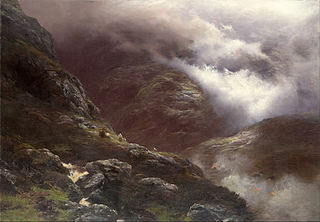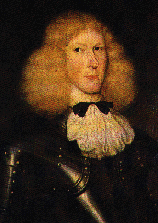
The Massacre of Glencoe took place in Glen Coe in the Highlands of Scotland on 13 February 1692. An estimated 30 members and associates of Clan MacDonald of Glencoe were killed by Scottish government forces, allegedly for failing to pledge allegiance to the new monarchs, William III and Mary II.

Clan Campbell is a Highland Scottish clan, historically one of the largest and most powerful of the Highland clans. The Clan Campbell lands are in Argyll and within their lands lies Ben Cruachan. The chief of the clan became Earl of Argyll and later Duke of Argyll.

A Scottish clan is a kinship group among the Scottish people. Clans give a sense of shared identity and descent to members, and in modern times have an official structure recognised by the Court of the Lord Lyon, which regulates Scottish heraldry and coats of arms. Most clans have their own tartan patterns, usually dating from the 19th century, which members may incorporate into kilts or other clothing.

Clan Donald, also known as Clan MacDonald, is a Highland Scottish clan and one of the largest Scottish clans. The Lord Lyon King of Arms, the Scottish official with responsibility for regulating heraldry in that country, issuing new grants of coats of arms, and serving as the judge of the Court of the Lord Lyon, recognises under Scottish law the High Chief of Clan Donald. Historically the chiefs of the Clan Donald held the title of Lord of the Isles until 1493 and two of those chiefs also held the title of Earl of Ross until 1476. Queen Mary of Denmark is member of Clan Donald.

Clan Maclean is a Highlands Scottish clan. They are one of the oldest clans in the Highlands and owned large tracts of land in Argyll as well as the Inner Hebrides. Many early MacLeans became famous for their honour, strength and courage in battle. They were involved in clan skirmishes with the Mackinnons, Camerons, MacDonalds and Campbells, as well as all of the Jacobite risings.

Robert Campbell, 5th Laird of Glenlyon, was a minor member of Scottish nobility and is best known as one of the commanding officers at the Massacre of Glencoe.

John Campbell, 1st Earl of Breadalbane and Holland, known as Sir John Campbell, 5th Baronet from 1670 to 1681, was a member of Scottish nobility during the Glorious Revolution and Jacobite risings and also known as "Slippery John". An astutely political man, Campbell was one of the men implicated in the Massacre of Glencoe.
Argyll's Regiment of Foot was a Scottish infantry regiment formed in April 1689 to suppress Jacobite opposition in the Highlands. In February 1692 it took part in the Glencoe Massacre, moved to Brentford near London in May then to Flanders in early 1693 where it fought in the Nine Years War. It became Lord Lorne's Regiment in April 1694 and was disbanded on February 1697.

Clan MacDonell of Glengarry, also known as Clan Ranald of Knoydart & Glengarry is a Scottish clan and is a branch of the larger Clan Donald. The clan takes its name from River Garry where the river Garry runs eastwards through Loch Garry to join the Great Glen about 16 miles (25 km) north of Fort William, Highland. The progenitor of the MacDonells of Glengarry is Reginald, 4th great-grandson of the warrior Somerled. The clan chief is traditionally designated as the "Son of Alexander's son".

Clan MacDougall is a Highland Scottish clan, historically based in and around Argyll. The Lord Lyon King of Arms, the Scottish official with responsibility for regulating heraldry in Scotland, issuing new grants of coats of arms, and serving as the judge of the Court of the Lord Lyon, recognizes under Scottish law the Chief of Clan MacDougall. The MacDougall chiefs share a common ancestry with the chiefs of Clan Donald in descent from Somerled of the 12th century. In the 13th century the Clan MacDougall whose chiefs were the original Lords of Argyll and later Lords of Lorne was the most powerful clan in the Western Highlands. During the Wars of Scottish Independence the MacDougalls sided with the Clan Comyn whose chiefs rivaled Robert the Bruce for the Scottish Crown and this resulted in clan battles between the MacDougalls and Bruce. This marked the MacDougall's fall from power and led to the rise of their relatives, the Clan Donald, who had supported Bruce and also the rise to power of the Clan Campbell who were then the habitual enemies of the MacDougalls and later of Clan Donald.
John MacDonald, known as Iain Lom was a Scottish Gaelic poet.

Clan Cameron is a West Highland Scottish clan, with one main branch Lochiel, and numerous cadet branches. The Clan Cameron lands are in Lochaber and within their lands lies Ben Nevis which is the highest mountain in the British Isles. The Chief of the clan is customarily referred to as simply "Lochiel".

Clan MacIntyre (McIntyre) is a Highland Scottish clan. The name MacIntyre, means "son of the carpenter.” It is most commonly said to descend from Maurice Mac Neil a nephew of Somerled, the great 12th century leader of the Scottish Gaels. Through an ingenious strategy, Maurice secured the marriage of Somerled to the daughter of the King of Mann and the Isles, thus greatly increasing Somerled's territories. At an unknown date the clan journeyed from the Hebrides to the Scottish mainland where the chiefs established their home at Glen Noe, in Ardchattan Parish, on the east side of Loch Etive.

The Clan Henderson also known as House of Henderson is a Scottish clan. The clan's historical seat is at Fordell Castle in Dalgety Bay, Fife. The current clan chief is Alistair Henderson of Fordell.

Clan Macdonald of Clanranald, also known as Clan Ranald, is a Highland Scottish clan and a branch of Clan Donald, one of the largest Scottish clans. The founder of the Macdonalds of Clanranald is Reginald, 4th great-grandson of Somerled. The Macdonalds of Clanranald descend from Reginald's elder son Allan and the MacDonells of Glengarry descend from his younger son Donald. The clan chief of the MacDonalds of Clanranald is traditionally designated as The Captain of Clanranald and today both the chief and clan are recognised by the Lord Lyon King of Arms, the heraldic judge in Scotland.

Clan MacDonald of Keppoch, also known as Clan MacDonellof Keppoch or Clan Ranald of Lochaber, is a Highland Scottish clan and a branch of Clan Donald. The progenitor of the clan is Alistair Carrach MacDonald, 4th great-grandson of the warrior Somerled. The clan chief is traditionally designated as the "Son of Ranald's son".

Clan Maclachlan, also known as Clan Lachlan, Clann Lachainn (Argyll), and Clann Lachlainn, is a Highland Scottish clan that historically centred on the lands of Strathlachlan on Loch Fyne, Argyll on the west coast of Scotland. The clan claims descent from Lachlan Mor, who lived on Loch Fyne in the 13th century, and who has left his name upon the countryside he once controlled: places such as Strathlachlan, Castle Lachlan and Lachlan Bay. Tradition gives Lachlan Mor a descent from an Irish prince of the O'Neill dynasty, Ánrothán Ua Néill, son of Áed, son of Flaithbertach Ua Néill, King of Ailech and Cenél nEógain, died 1036. Clan Maclachlan has been associated with other clans, such as Clan Lamont, Clan Ewen of Otter, Clan MacNeil of Barra, and the MacSweens: as all claim descent from Anrothan O'Neill who left Ireland for Kintyre in the 11th century. From this descent the clan claims a further descent from the legendary Niall Noigíallach, High King of Ireland, who lived from the mid 4th century to the early 5th century.

Clan Macfie is a Highlands Scottish Clan.

Lady of the Glen: A Novel of 17th-Century Scotland and the Massacre of Glencoe is a 1996 historical fiction novel by American author Jennifer Roberson. It is a re-telling of the 1692 Massacre of Glencoe, and focuses on the romance between Catriona of Clan Campbell and Alasdair Og MacDonald of Clan Donald, each from rival clans.

Lochalsh is a district of mainland Scotland that is currently part of the Highland council area. The Lochalsh district covers all of the mainland either side of Loch Alsh - and of Loch Duich - between Loch Carron and Loch Hourn, ie. from Stromeferry in the north on Loch Carron down to Corran on Loch Hourn and as (south-)west as Kintail. It was sometimes more narrowly defined as just being the hilly peninsula that lies between Loch Carron and Loch Alsh. The main settlement is Kyle of Lochalsh, located at the entrance to Loch Alsh, opposite the village of Kyleakin on the adjacent island of Skye. A ferry used to connect the two settlements but was replaced by the Skye Bridge in 1995.





















